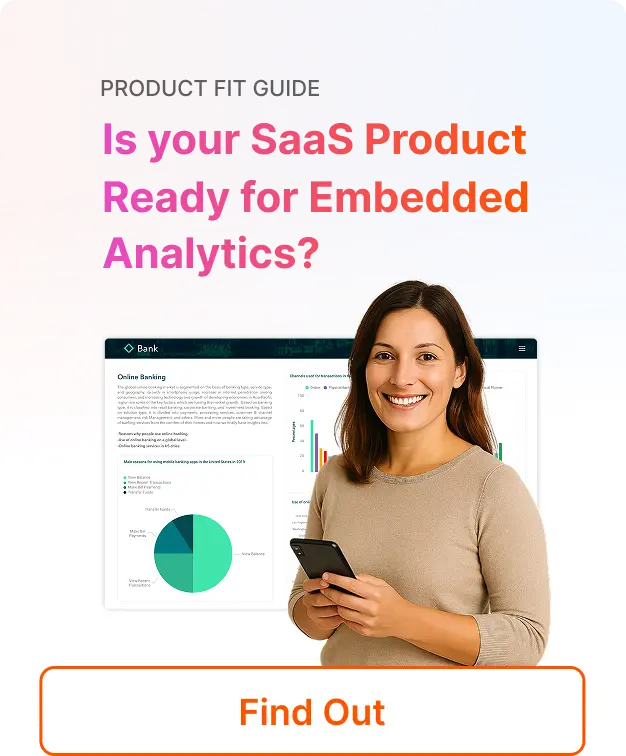Embedded analytics is the technological capability to include analytics features and functions as an inherent part of another application.
According to the Dresner Wisdom of Crowds® 2023 Embedded Business Intelligence Market Study, current use of embedded BI is at 49 percent and adoption plans remain strong. Additionally, eighty-six percent of industry respondents say embedded BI is critical or very important.
In this comprehensive embedded analytics guide, we answer the burning question, “what is embedded analytics” and explore how it can transform your customers’ experience from confusing to confident.
Embedded Analytics Meaning
An embedded analytics for SaaS solution enables users of a SaaS application to harness the power of business intelligence to analyze the data they create inside that app. This eliminates the need to export data only to import it into a separate business intelligence tool.
How Embedded Analytics Works
Embedded analytics seamlessly integrates into a host application, matching its look, feel, and branding so that users experience analytics as a natural part of the software. Instead of switching between multiple embedded analytics tools, users can access insights and data visualizations directly within their workflow.
There are multiple ways to embed analytics, each offering different levels of integration and flexibility. For a real-world sample of embedded analytics, companies can explore examples that showcase how different integration approaches impact usability and functionality. Organizations can choose between out-of-the-box visualizations provided by an analytics platform or fully customized visualizations that align with specific business needs. Additionally, third-party libraries can be embedded to further tailor the experience.
Common Methods for Embedding Analytics:
- iFrames & HTML – Quick and simple, but limited in flexibility and branding.
- Web Components – Offers better integration while maintaining modularity.
- React SDK & API Calls – Provides the highest level of customization, ensuring a fully embedded experience.
The choice of embedding method depends on the desired level of control, security, and user experience. By integrating analytics directly into SaaS applications, companies create a more seamless and engaging data experience.
Embedded Analytics Benefits
Embedded analytics for SaaS applications can provide significant advantages for both the software vendor and end users. With embeddable analytics capabilities like dashboards, embedded reporting, and predictive insights into a SaaS application, vendors can enhance their offerings and provide additional value for customers, showcasing the benefits of embedded analytics in improving user experience and business decisions.
Increase revenue
Monetizing analytics in several ways, through premium user tiers that unlock more advanced capabilities, add-on products that extend functionality, and professional services to help customers analyze their data alongside professionals.
Embedded analytics in business processes presents new revenue streams beyond standard software subscriptions.
Paddle, a provider of payment infrastructure for SaaS companies, conducted a study of 512 SaaS companies. The results show monetization was four times more efficient than acquisition in improving growth. Additionally, it is twice as efficient than efforts to improve retention.
Enhance customer satisfaction & engagement
Provide customers with a seamless and intuitive user experience. Allow them to access and interact with data and insights within their workflow without having to switch to a separate analytics tool or platform.
Increase customer satisfaction & retention rates
Provide customers with valuable insights to help them solve problems and achieve their goals. Higher NPI scores result from empowering users to get answers to their questions quickly without the need for technical skills or leaving the software.
Additionally, the more users can do with a SaaS application, the more they rely on it. As customers are satisfied with your application and rely on it as an integral tool in their business, they’re likely to remain loyal customers.
Differentiate from competitors
Offer a unique and innovative value proposition that can help your users enhance decision-making and improve performance.
Access real-time data.
Embedding analytics also allows for access to real-time data within the application environment users are already working in. Rather than exporting data to analyze in another tool, insights are available immediately within the workflow.
This leads to stickier applications that users rely on more heavily as a single source of truth.
Avoid building in-house & maintain focus on your roadmap.
Every hour you spend adding analytics to your software is an hour not spent focusing on your core competitive differentiation (that’s assuming that you’re not an analytics provider like Qrvey!) Building analytics will also put a drag on your entire product roadmap as valuable resources are slowly siphoned away.
By embedding analytics functionality from a third-party vendor, you avoid building in-house. This accelerates your time to market. Purchasing a third-party product also lowers development costs.
Implementing Embedded Analytics
Integrating embedded analytics into a SaaS platform requires choosing the right implementation method. Each approach offers different levels of flexibility, ease of integration, and user experience. The best method depends on your development resources, customization needs, and security requirements.
Method 1: iFrames
iFrames are a straightforward way to embed analytics, requiring minimal development effort.
Pros:
- Quick to implement with little coding.
- Works with most web applications.
- Maintains security by isolating content from the main application.
Cons:
- Limited customization and branding control.
- Can lead to performance issues and slower load times.
- Security concerns, as some applications restrict iFrame usage.
Method 2: Web Components
Web components provide a more flexible way to integrate analytics, embedding modular, reusable elements into the application.
Pros:
- Provides a smoother user experience with better integration.
- Greater control over styling and interaction.
- Works across various frameworks and platforms.
Cons:
- Requires more development effort than iFrames.
- Some older browsers may not fully support web components.
Method 3: React SDK
Using a React SDK allows for deep integration within React-based applications, offering a seamless experience.
Pros:
- Fully customizable to match application design and behavior.
- Better performance than iFrames.
- Supports dynamic interactions and advanced functionality.
Cons:
- Requires a React-based frontend or extra development effort for non-React apps.
- More complex setup compared to plug-and-play solutions.
Method 4: API-Driven Embedding
APIs allow for embedding analytics at a granular level, giving full control over how data and visualizations are presented.
Pros:
- Maximum flexibility and customization.
- Enables advanced automation and user-specific experiences.
- Works across different technology stacks.
Cons:
- Requires strong developer expertise.
- Longer implementation time compared to pre-built solutions.
Method 5: JavaScript Embedding
JavaScript-based embedding offers the best of both worlds—high customization with better performance than iFrames.
Pros:
- Fully interactive and responsive.
- Avoids iFrame limitations while keeping setup relatively simple.
- Allows for better security controls.
Cons:
- Requires moderate development work.
- Some third-party analytics platforms may not fully support JavaScript-based embedding.
Choosing the Right Method
The best approach depends on your SaaS platform’s needs, technical resources, and desired user experience. A low-code solution like iFrames may work for quick deployment, while an API-driven or JavaScript approach provides full customization and performance optimization. Your product team should consider factors like customization, performance, and security when selecting an embedding method that best fits your SaaS applications.
Want to see embedded analytics in action? Request your demo of Qrvey today.
12 Crucial Embedded Analytics Features
1. Self-Service, Easy-to-Build Charts & Dashboards
Users should be able to simply point and click to build beautiful data visualizations. A self-service analytics chart builder should be easy to use. User experience is the most important aspect. So be sure you can teach your users to learn the dashboard builder.
Read about how Qrvey allowed Impexium to go to market quickly and get analytics into the hands of their customers. The company needed to replace their legacy analytics platform with a modern solution with self-service capabilities, responsive design, and data automation.
2. Any Type of Data
More than 70% of all business data is never used for analysis because most traditional analytics tools only work with structured data. To gain vital insights, you must be able to integrate all of your data, including semi and unstructured data sources like forms and images.
3. Workflow & Automation
It’s great if users can discover new insights with your analytics platform – but better yet if the platform does the discovering for users! Workflow automation can alert users when conditions are met, and workflows can be triggered if thresholds are exceeded.
With self-service workflow builders, even non-technical users can easily automate common tasks. Automation can be triggered automatically as new data is received or when user-defined metrics and thresholds are met. This empowers data-driven application development.
Add powerful business logic to your workflows and applications with conditional rules and ML models. Only with automation can your analytics platform be working for you 24 hours a day.
4. Shareable Insights
Once users have obtained valuable insights, they should be able to easily share and disseminate them. Look for features such as the ability to create multi-page and multi-tab reports that include full interactivity and data security built right in. With content deployment features, you can roll out templates and dashboards to specific tenants at your own pace.
5. Interactivity such as Drill Down & Drill Through
Users should be able to interact with reports to easily access additional info as needed. Drill down takes users from a high level to a more granular one, allowing users to go deeper into the data, for example from country to state.
Drill through takes the user to a report relevant to the data being analyzed, passing to another report while still analyzing the same data set.
Finally, advanced filtering options enable users to refine the data that is displayed in reports.
6. Data Security & Managed Access Controls
Record- and column-level security allows administrators to restrict data access at granular levels in a dataset, so each user gets only the information they are authorized to see. Grant access to data, insights, and applications according to each user’s role.
Security tools and features must support multi-tenant SaaS applications and ideally will inherit your security model, including all of your rules and policies. Seamlessly integrate analytics into your SaaS application with single sign-on.
7. Deployable to Your SaaS Platform Environment
Being able to deploy the embedded analytics software to private environments for maximum data security is a crucial feature in maintaining control over data. Additionally, this method will inherit your existing security policies rather than forcing you to rely on a third party to manage your data.
By deploying into YOUR cloud, your data never leaves your account, enabling you to keep your data in your environment under your control.
To fit into software development lifecycles (SDLC), you should also be able to deploy to code repositories and multiple development environments.
8. White Labeling & UI Customization
There are many benefits to embedding a third-party product instead of building everything in-house. But your customers don’t need to know. Embedded analytics should be fully customizable, including updating the look with CSS and themes to ensure seamless blending into your SaaS application. The user experience should be consistent, and white label analytics offers the flexibility to match your brand’s look and feel. This is why white-label embedded analytics is the way to go.
The Dresner Wisdom of Crowds® Business Intelligence Market Study recognizes the importance of customization abilities. The Study rates vendors using a 33-criteria evaluation model, including “customization and extensibility” within the category of “quality and usefulness of product.”
9. Native Multi-Tenancy
Out-of-the-box multi-tenancy is essential for SaaS use cases. This also directly affects the time to market, as many solutions require extensive custom development to force multi-tenancy.
10. Unlimited User Licensing
Predicting usage within a SaaS application is nearly impossible, so an ideal solution will provide unlimited user licensing. Most traditional business intelligence solutions can only offer user licensing and that tends to be a blocker to adoption.
User-based licensing is a significant cost driver that can prevent you from achieving a positive ROI.
11. Everything is Embeddable
A proper embedded analytics solution must provide multiple components that are fully embeddable using Javascript and avoiding iframes for a seamless user experience. You should be able to embed dashboard and chart widgets, dashboard and chart builders, data management, automation rule management, and more.
12. Easy Data Integration
Pre-built database connectors and easy-to-use APIs are essential to rapid integration and fast time to market. Additionally, native support for both structured (SQL) and semi-structured (NoSQL) data means more flexibility, reducing the need for useless transformations and wasted processing.
We also have a guide for what features to consider when evaluating embedded analytics vendors.
The Role of AI and Machine Learning in Embedded Analytics
AI and machine learning (ML) are transforming embedded analytics by making data insights more predictive, automated, and actionable. Instead of relying solely on historical reports and dashboards, AI-powered analytics proactively surfaces insights, detects patterns, and even triggers automated actions.
Key AI/ML Capabilities in Embedded Analytics
1. Automated Anomaly Detection
AI-driven analytics can monitor datasets in real time, identifying unusual patterns, spikes, or declines that might go unnoticed in traditional reporting. This helps businesses detect fraud, operational inefficiencies, or performance issues before they escalate.
2. Predictive Analytics for Data-Driven Decision Making
Machine learning models can analyze past trends to forecast future behaviors, risks, and opportunities. SaaS platforms can use this to anticipate churn, optimize resource allocation, or personalize user experiences based on predictive insights.
3. AI-Powered Data Visualization
Instead of manually building dashboards, AI can automatically generate smart visualizations tailored to user behavior, making it easier to surface the most relevant insights without digging through data.
4. Natural Language Querying (NLQ)
AI-powered analytics allows users to ask questions in plain language (e.g., “What were our top-selling products last quarter?”) instead of relying on complex queries or filters. This democratizes access to insights, making analytics more accessible to non-technical users.
5. Automated Decision-Making & Workflow Triggers
AI-driven analytics doesn’t just report insights—it acts on them. For example:
- If inventory levels drop below a threshold, the system can trigger an automatic restock order.
- If user engagement drops, AI-powered analytics can automatically suggest optimizations for retention.
Why AI/ML-Enhanced Embedded Analytics Matters for SaaS
SaaS applications are increasingly expected to provide real-time, intelligent insights, not just static reports. By embedding AI-powered analytics, SaaS providers can:
- Enhance customer engagement with proactive recommendations.
- Optimize operations by automating decision-making.
- Monetize AI-powered analytics as a premium feature.
AI-driven embedded analytics doesn’t just improve reporting—it turns analytics into an intelligent, action-oriented engine that helps businesses move faster and make smarter decisions.
The Biggest Embedded Analytics Challenges (and How to Overcome Them)
While embedded analytics offers powerful advantages, SaaS companies often encounter roadblocks when implementing it. Below are some of the most common challenges and how to mitigate them.
Server Fees & User-Based Licensing
Some traditional BI solutions that began with a dependence on server installations may still require licensing for each server their software is installed on. Trying to integrate with a software development process or scale a cluster becomes cost-prohibitive over time.
Additionally, user-based licensing is a significant cost driver and often an underappreciated expense. Companies that try to “start small” rarely realize the ROI of their investment when they’re suddenly hit with massive costs just to expand access to more users.
Data Access & Synchronization
Odds are that your app uses more than one type of data… and if it doesn’t now, it certainly might in the future. Therefore, your analytics solution must be able to work with any type of data and handle the complexity of combining multiple sources.
When embedding analytics architecture, you don’t want to be locked into one architecture or forced to go through the hassle of reshaping your data just to fit a rigid system.
Example: Qrvey helped Global K9 overcome the struggle of analyzing all the data gathered via video capture. With Qrvey, Global K9 was able to definitively prove to airlines and government agencies that their canine teams can safely process more cargo tonnage than traditional x-ray technologies.
Forcing Data Transfer to a Third-Party Cloud
An ideal solution keeps your data right where it is—in your environment, under your control. If you send your customers’ data to a third-party cloud, you’ll need to conduct a comprehensive security audit to ensure compliance with industry regulations and data privacy laws.
No Support for Development Environments
As a SaaS company, your development lifecycle is different from that of an internal IT department at a large enterprise. If your embedded analytics software cannot be installed in separate development environments (e.g., staging, testing, production), you’re taking unnecessary risks with your product.
Lack of Built-in Scalability & Performance
Your SaaS application is designed to grow—but what happens when your analytics solution can’t keep up? Some embedded analytics platforms buckle under scale, leading to latency issues and frustrating user experiences.
Ideally, your solution should scale without a costly, time-consuming rebuild. As your application grows, your analytics solution should scale proportionally, not exponentially in cost. If achieving 15% growth increases costs by 80%, you’ve got a problem.
Not AI-Ready
Artificial Intelligence is everywhere, and embedded analytics should be no exception. But here’s the catch: Many vendors claim to offer AI-powered analytics, but slapping an “AI” label on a product doesn’t make it intelligent.
Look for analytics platforms that actually leverage machine learning and AI to enhance automation, surface insights, and make predictions—not just ones that use AI as a buzzword. Qrvey offers truly AI-powered embedded analytics.
iFrame Embeds
Many traditional BI tools can embed dashboards, but often they rely on iFrames, which introduce major limitations:
- iFrames Security risks—many infosec teams reject iframe-based solutions outright.
- Poor mobile responsiveness—iframes don’t always adapt well to different screen sizes.
- Limited interactivity—iframes often function as static views rather than dynamic tools.
Instead, modern SaaS providers are opting for JavaScript-based widgets that offer seamless interaction, better security, and a more native feel within their applications.
Not Setting Clear Goals
It’s not enough to just say, “We’re adding analytics to our product.” You need to define why and how analytics will improve your product and user experience.
Are you aiming to increase user engagement, monetize data, or optimize decision-making? Without clear goals, you might end up with a flashy dashboard that no one—internal users or customers—actually uses.
Not Assembling the Right Team
If you plan to bring analytics to a large number of users, everyone’s feedback must be considered. Developers, product managers, data analysts, and end-users should all have a seat at the table when designing your embedded analytics experience.
Your customers will have plenty of things they hope to do with your analytics software—make sure you embed a self-service solution that can easily handle those needs.
Choosing the Wrong Architecture
Architecture matters. Choosing an outdated, legacy BI system will limit your flexibility, scalability, and performance. A modern, cloud-native solution ensures that you can offer analytics to more people, across more environments, with fewer headaches.
Forgetting About Good Design
Not everyone using your analytics tool will be a data scientist. Fortunately, they don’t have to be.
A well-designed analytics solution should be intuitive enough for non-technical users to explore data, create reports, and uncover insights without requiring extensive training.
Not Including All Your Data
This is a big one. According to industry research, only a small fraction of corporate data is ever analyzed, leaving users with incomplete insights.
The problem? Semi-structured and unstructured data—which most BI tools simply can’t process. If your analytics platform can’t handle all data types (including NoSQL, logs, forms, and images), you’re only getting part of the story.
Forgetting About Integration
Analytics only provides value if people actually use it. That means it needs to be fully embedded into the applications your users already rely on daily.
Many solutions claim to be “embeddable,” but true embedded analytics is built from the ground up for integration—without requiring unnecessary workarounds like iFrames.
Missing the Boat on Privacy & Security
The security and privacy of your customers’ data should be top priority. Many companies simply can’t risk sending their data to an external analytics provider.
That’s why Qrvey deploys analytics into your cloud environment—so you stay in control of your infrastructure, security, and compliance requirements.
Neglecting Automation
There’s only one thing better than discovering new insights in your analytics platform—having the platform do it for you.
Automation is often overlooked in embedded analytics, but it shouldn’t be. By setting up proactive alerts, workflows, and AI-driven recommendations, you ensure your users don’t just get insights—they get actionable insights, when they need them most.
Embedded Analytics Use Cases
SaaS applications exist in all industries today, therefore embedded analytics serve a great need across any industry. Nearly all SaaS applications are expected to have a strong analytics offering, so if you only offer static, generic dashboards, your customers are likely left wanting more.
Following are some popular industry use cases.
Embedded Analytics for SaaS Applications
Reporting features for embedded SaaS analytics within SaaS applications may seem like table stakes, but it’s often an area where SaaS companies can separate themselves from their competition. Qrvey allows SaaS companies to create richer products and bring them to market faster while lowering development costs.
Building embedded analytics in-house is a time-consuming and roadmap-intensive feature that SaaS companies don’t need to undertake.
Healthcare Analytics
With a focus on security, Qrvey’s healthcare analytics solutions enable teams to analyze data within your cloud environment.
Healthcare solutions often include various types of data – SQL, NoSQL, and unstructured data sources like forms and images. It’s vital to connect to any data source, including FHIR-Compliant patient health records. For comprehensive insights, you need to analyze multiple healthcare data sources on a single dashboard. Your analytics solution must be fully compliant with the HL7 FHIR patient medical record standards to integrate within healthcare analytics tools.
By analyzing many different data sources, you can gain insights across an entire practice.
- Uncover patient trends by ingesting and analyzing FHIR analytics data and conducting granular analysis.
- Analyze patient data to find patterns, predict health risks, and create treatment plans.
- Analytics can help doctors diagnose diseases more accurately and quickly by using algorithms and machine learning to analyze symptoms, test results, and medical images.
Analytics can also help doctors provide personalized and proactive care to their patients, such as identifying patients at risk of developing certain diseases.
For clinical trials
Examine large data volumes to spot trends early with in-depth analysis of trial spending in real-time. Also, you can:
- Improve the quality of care by collecting real-time patient feedback and analyzing outcomes as the data comes in.
- Boost evidence-based decision-making by empowering researchers and policymakers to analyze vast amounts of clinical data. This leads to identifying trends, evaluating treatment effectiveness, and developing guidelines for best practices.
Healthcare SaaS vendors can also use analytics to power improvements in operational efficiency. Insights from analyzing patient flow, staff productivity, and equipment usage can identify bottlenecks, delays, or waste, and lead to enhanced efficiency and reduced costs.
Detect and prevent fraud
Prevent abuse by analyzing claims data to identify suspicious activities, such as billing irregularities, duplicate claims, or false diagnoses. This approach can save money for healthcare organizations as well as protect patients from unnecessary procedures or treatments.
Predict Patient Outcomes
Analytics can also enable healthcare providers to predict patient outcomes and anticipate healthcare needs. Analyzing information, such as medical records, prescriptions, or lifestyle data, can help doctors find patients at high risk who may need extra care or check-ups. This proactive approach can allow for timely interventions, reducing hospital readmissions and improving patient satisfaction.
Predictive analytics can also help healthcare providers forecast demand and supply, resulting in improved planning and resource allocation.
Financial Analytics
Transform your financial data into actionable insights with financial analytics software. Visualizing financial data allows for easier comprehension and interpretation of complex data sets. Instead of deciphering numbers and tables, visual representations provide a more intuitive understanding of financial trends and performance.
With interactive visualizations, users can manipulate and explore financial data, uncovering hidden insights and patterns that may not be apparent in traditional tabular formats. By embedding interactive analytics directly into financial platforms, you can provide users with immediate access to analytics within familiar systems and accelerate time-to-value.
Financial organizations report paying more than $4 fighting fraud for every $1 of fraud loss, leaving a huge opportunity for smarter analytics to uncover potential fraud. AI in particular has great potential to identify patterns and reduce false positives.
With granular analysis of large data sets, you can uncover trends and find anomalies. By connecting to any data type – SQL, NoSQL, and unstructured data sources like forms and images – you can analyze multiple financial data sources on a single dashboard. Combine data sources to unify financial software and achieve performance insights across an entire organization.
With maximum data security, teams can safely analyze sensitive data, from individual records to entire financial practice performance all within your SaaS platform.
With an API layer built for rapid development, data can be pushed directly from the source for real-time analysis within your financial analyst software solution. Automation and alerting help keep you up-to-date and keep your processes in line.
Logistics Analytics Solutions
Organizations generate large amounts of data around the procurement, processing, distribution, and transportation of goods. In particular, IoT sensors used to monitor manufacturing and logistics equipment generate large volumes of data.
Qrvey’s IoT analytics platform is one solution.
Supply chain analytics involves collecting and analyzing data across the supply chain to gain visibility, identify insights, and optimize planning and execution. When embedded into supply chain apps, logistics analytics solutions empower you to gain insight and extract real value from that vast amount of information. Improve operations with better process planning and forecasting.
AI is changing the face of supply chain analytics platforms. AI and machine learning can automate the analysis of large volumes of historical data and provide real-time insights as well as forward-looking decision-making. RFID data can also be analyzed for shelf-space optimization, dynamic pricing, and out-of-stock prevention. Make the most efficient use of warehouse space.
Transportation analytics and GPS technologies can enable you to minimize travel distances, reducing fuel consumption and improving driving efficiency. Supply chain analytics software can quickly surface patterns and trends and offer embedded decision logic to improve efficiency, increase productivity, and dramatically lower costs in everything you do.
IT and Cybersecurity Analytics Solutions
IT software vendors are the glue that help companies plan, execute, and complete successful digital transformations. According to BetterCloud’s 2023 State of SaaSOps report, organizations now use an average of 130 apps. This represents an increase of 18% from the previous year, despite 40% of IT professionals saying they consolidated redundant SaaS apps.
As the number of cloud services has exploded, the complexity of integration options has also grown. With substantial complexity in the age of digital transformation, the need for powerful, flexible, and scalable IT analytics solutions continues to increase.
Cybersecurity analytics platforms must uncover misconfigurations and detect indicators of compromise to mitigate risks, but unfortunately, they’re often overrun with false positives. By enabling embedded analytics of real-time data, cybersecurity platforms can improve accuracy.
With the explosion of SaaS apps, IT costs are also rising. Analytics can equip organizations with the insights needed to reduce unnecessary costs and ensure that spending is optimized. Additionally, quantify the business value of IT to demonstrate ROI.
Analytics can also provide vital KPIs such as system response time, availability, and user satisfaction. Optimize IT processes like incident handling and predict future IT resource needs based on demand forecasts.
Embedded Analytics Requirements
To support a strong analytics feature set within a SaaS application, the data layer must first be ready to handle multi-tenant reporting.
Multi-Tenant Data Layer
Having a standard, out-of-the-box database or data warehouse is not enough to achieve a multi-tenant embedded analytics function. You will need a multi-tenant data lake that handles the security, mapping of roles and permissions, and an easy-to-use to use API suite so that integration is fast.
Being able to host this solution yourself is also a key to achieving the security that most SaaS companies require. While there are no shortage of third party, cloud host data management systems out there, as soon as your data leaves your environment it poses a security risk. Are you ready to be responsible for a third party platform?
And since data comes from many sources these days, how flexible the data solution is becomes an important question.
- Does it force every tenant to use the same data model for data analytics or can it be customized?
- Does it only work with structured/relational data or can it handle semi/unstructured data?
- Does it only work with prebuilt data connectors or is there an API to push on custom intervals?
Front End Visualizations
Having embedded dashboards is not enough. For true embedded analytics within a multi-tenant SaaS application, you’ll need:
- Embedded data visualizations: full dashboards AND individual charts
- Embedded dashboard builders
- Embedded chart builders
- Javascript components, not iFrames
- White label support: full CSS controls, not just changing logos
- Automation and alerting that users can build themselves
What are Embedded Data Widgets?
Widgets are simple, intuitive applications independent of the body of a website or device but easily embedded into it. Widget types include information, collection, control and hybrid. Data widgets display one object, or a list of objects using live data that may be programmed to respond to website identity. Types of data widgets include data view, data grid, template grid, and list view.
Traditional Business Intelligence (BI) vs Embedded Analytics
Most BI companies were founded between 2000 and 2010 and targeted enterprises needing to analyze data internally. SaaS wasn’t yet the dominant force it is today, so these systems were designed to be installed in servers owned by each customer and managed by a database administrator from the IT department.
In, “How to Select an Embedded Analytics Product,” author Wayne Eckerson writes, “Most BI tools were not designed for embedding; converting a stand-alone, commercial product into one that can be easily embedded in both single- and multi-tenant environments with full fidelity is challenging.”
As the number of SaaS products each company uses has exploded, analytics providers have struggled to pivot from a server-focused software product to a cloud-focused product. The following are four primary ways embedded analytics vs embedded BI compare:
| Traditional BI software | Embedded Analytics | |
| Developer Friendliness | Traditional BI software includes self-service tools and embedded dashboards only.It never provided the developer audience with the necessary tools (widgets, APIs, security options, etc). Developers have no chance to create multi-tenant analytics platform that power end-user customizations. | Built from the ground up for developers, with an API-first approach with no-code widgets that deliver real value in terms of time and cost savings. |
| Costs | Traditional BI systems sell server licenses and user licenses. It’s much tougher for SaaS providers to predict usage across a platform that has 500+ customer tenants on it. | Embedded analytics aligns with SaaS providers’ by charging based on value. To that end, unlimited users is the only way to scale an embedded analytics feature. |
| Architecture | Traditional BI software is particularly difficult to embed within a multi-tenant SaaS app. BI apps are server-based systems that were never meant to scale with cloud platforms like AWS without costly server clustering. | Qrvey’s embedded BI deploys into your cloud environment with a full suite of security tools and features that support multi-tenant SaaS applications. Your data never leaves your account. |
| Data Readiness | Embedded analytics aligns with SaaS providers by charging based on value. To that end, unlimited users is the only way to scale an embedded analytics feature. | Analyze various types of data – SQL, NoSQL, and unstructured data sources like forms and images. Qrvey is also a multi-tenant-ready data lake built exclusively for SaaS applications. |
Choosing the Right Embedded Analytics Platform
The right embedded analytics solution depends on several factors, but in our experience, the successful solution will:
- Include a multi-tenant data lake purpose-built for multi-tenant analytics.
- Offer an intuitive user experience that doesn’t require extensive training.
- Be deployed and self-hosted to maximize data security.
- Provide a robust API suite for easy integration.
- Support full white-label capabilities so you maintain control over branding.
- Most importantly, enable SaaS users to analyze data according to their own business processes.
How Much Does Embedded Analytics Cost? Pricing Models Explained
Unlike traditional BI tools, which often rely on per-user licensing, modern embedded analytics platforms offer more scalable pricing structures based on actual usage. Here’s a breakdown of common pricing models:
Per-User Pricing
Some vendors charge based on the number of users who access analytics. While predictable for small teams, this model can become cost-prohibitive as user numbers grow. Many SaaS providers prefer alternatives that allow unlimited users.
Per-Query Pricing
A usage-based approach where companies pay for each analytics query or report generated. This model scales with demand but may lead to unpredictable costs, especially for data-heavy applications.
Per-Workspace or Tenant Pricing
Ideal for multi-tenant SaaS platforms, this model charges per customer workspace, regardless of the number of end-users. This structure aligns costs with revenue growth and avoids per-user restrictions.
Flat-Rate or Tiered Pricing
Some analytics providers offer fixed-cost packages based on features, data volume, or usage tiers. This provides predictability but may require upgrading as needs grow.
Self-Hosted vs. Cloud-Hosted Costs
- Self-hosted analytics solutions deploy directly into your cloud environment, eliminating third-party storage fees and giving you full control over security and compliance.
- Cloud-hosted solutions may charge for storage, compute resources, or API requests, adding additional operational costs over time.
The right pricing model depends on your business needs. SaaS companies with high user counts or data volumes often benefit from unlimited-user or tenant-based pricing to ensure scalability without unexpected expenses.
Curious about costs? Request a demo to explore pricing options tailored to your needs.
Embedded Analytics Applications
Qrvey is the only complete embedded analytics for SaaS solution to rapidly add a modern analytics layer with rich capabilities that are easily configurable for all types of users. By using Qrvey’s platform to embed analytics within their products, SaaS firms can deliver greater value, unlock new revenue streams, and ensure greater customer loyalty.
Unlike traditional BI solutions, which typically require integrating numerous, separate functions, Qrvey delivers a complete, no-code, end-to-end platform that deploys entirely within our customers’ cloud environments, lowering the time and cost of development, deployment, and maintenance.
It is the best-embedded analytics platform built specifically for cloud-native environments, leveraging the best of cloud technology to offer rapid deployment of self-service analytics across any type of data.
Qrvey’s platform creates the most cost-effective embedded analytics solution on the market, driven by a team with decades of experience in the analytics industry. Qrvey has been recognized as a leader by Dresner Advisory Services and voted a high performer on G2.
The Process of Embedding Analytics
The following describes the initial onboarding process for new customers of the Qrvey platform.
Install Qrvey Software
- Install and configure the Qrvey platform in your cloud platform. (we do free trials too FYI)
Create a new application
The Qrvey platform offers a wide range of features that can be used in a Qrvey application, including web forms, data connections, analytics, and automation.
- Create a connection to a data source
- Create a data set
- Build a dashboard
- Publish the application
- Embed the Qrvey application into your host application
Obviously, there are a few more steps, but that’s the idea. Our goal is to get you up and running fast.
If you are interested in learning more about our embedded analytics solution or want to see how it can work for your product, please contact us for a free demo.
Why Qrvey Is the Best Embedded Analytics Solution for SaaS
Choosing the right embedded analytics solution can determine how successfully your SaaS application delivers insights to users. Qrvey was built specifically for SaaS providers who need a scalable, fully embeddable, and self-hosted analytics platform—without the limitations of traditional BI tools.
Unlike other solutions, Qrvey deploys directly into your cloud environment, meaning your data stays secure and under your control. With a fully API-driven approach, no-code automation, and AI-powered insights, Qrvey enables you to embed analytics seamlessly into your application while giving your users the power to explore, visualize, and automate their data.
Whether you’re looking to monetize analytics, improve customer retention, or reduce development time, Qrvey provides the most flexible and cost-effective path to delivering powerful analytics within your SaaS product.
Ready to see Qrvey in action? Request a demo today.

Natan brings over 20 years of experience helping product teams deliver high-performing embedded analytics experiences to their customers. Prior to Qrvey, he led the Client Technical Services and Support organizations at Logi Analytics, where he guided companies through complex analytics integrations. Today, Natan partners closely with Qrvey customers to evolve their analytics roadmaps, identifying enhancements that unlock new value and drive revenue growth.
Popular Posts
Why is Multi-Tenant Analytics So Hard?
BLOG
Creating performant, secure, and scalable multi-tenant analytics requires overcoming steep engineering challenges that stretch the limits of...
How We Define Embedded Analytics
BLOG
Embedded analytics comes in many forms, but at Qrvey we focus exclusively on embedded analytics for SaaS applications. Discover the differences here...
White Labeling Your Analytics for Success
BLOG
When using third party analytics software you want it to blend in seamlessly to your application. Learn more on how and why this is important for user experience.









